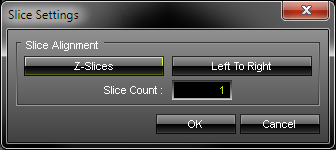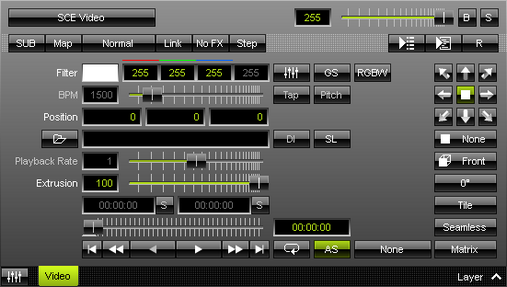This topic includes:
SCE Video allows you to load a video file into MADRIX and display it on your LEDs.
|
|
 Default Settings |
 Customized Example |
| ▪ | Various buttons and controls have universal functions. They are available for each MADRIX Effect / Layer. Learn more »Effect Areas [Left/Right] Learn more »Layers |
This MADRIX Effect uses the following, individual controls:
| ▪ | Filter - Applies a multiplicative color filter to the image. The default value is White. - GS - Activates grayscale mode to show the input only in gray shades. The Filter is independent of this mode. - RGBW - Converts the input into RGBW. This is useful when using RGBW fixtures to convert from the standard RGB color values of the input. If the option is disabled when using RGBW fixtures, the input will appear darker since the White channel is not used. The W color channel of the Filter only works if RGBW is activated. Learn more »Using Colors And Intensity |
| ▪ | BPM - Defines the speed [when using a direction/movement]. The default value is 1500. Valid values range from 0 to 9999. Learn more »Using BPM Control |
| ▪ | Position - Defines the position of the image in X, Y, and Z [in %]. The default values are 0, 0, 0. Valid values range from -1000 to 1000. |
| ▪ | Playback Rate - Defines the speed of the Image Table and how fast images are changed. - The default value is 1, which means that the Duration of the Image Table for each image is used. A rate of 2 doubles the speed and cuts the Duration in half, for example. - Is only supported by specific video codecs [such as, QuickTime]. |
| ▪ | Extrusion - Adds depth to the input; i.e. duplicates the input image [in %]. This is mainly relevant for 3D. The default value is 100. Valid values range from 0.01 to 100. |
|
Open - Allows you to load a video into MADRIX. Select the file on your computer or another source. |
|
Start Time - Displays the Start Time of the video. The time format is hours:minutes:seconds [HH:MM:SS]. Spacebar - Resets to the default value. |
|
Set Start Time - Allows you to define an individual Start Time to begin the video at a different position. First, please enter a different Start Time. |
|
End Time - Displays the End Time of the video. The time format is hours:minutes:seconds [HH:MM:SS]. Spacebar - Resets to the default value. |
|
Set End Time - Allows you to define an individual End Time to let the video end/stop at a different position. First, please enter a different End Time. |
|
Position Slider - This slider shows the current position of the video. |
|
Current Position - Displays the current position of the video. The time format is hours:minutes:seconds [HH:MM:SS]. |
|
Skip To Start - Instantly skips to the Start Time of the video. |
|
Play - Starts the video playback. |
|
Pause - Allows you to pause video playback. The video stops at the current position. |
|
Playback Mode - Allows you to define the playback behavior. Once [Set Position To End Frame] - Plays back the video normally, one time, from start to end. The Position will remain at the End Time. Once [Set Position To Start Frame] - Plays back the video normally, one time, from start to end. The Position will jump back to the Start Time. Loop [Default] - Activates forward [or backwards] looping. The video file will be played back repeatedly in a loop. Bounce - Activates changing the playback direction when reaching the video End Time or Start Time. Is only supported by specific video codecs [such as, QuickTime]. |
|
Autostart - Automatically starts the video after it has been loaded into MADRIX or after changing a Storage Place. |
|
Filtering - Defines how input is processed and displayed. Mainly affects the visual outcome when the input is scaled up or down [e.g., when choosing a different mode for Stretching / Aspect Ratio]. Choose from 2 different modes. The default setting is None. |
|
Deinterlace Mode - Allows you to choose from several Deinterlace Modes. Often digital cameras, digital broadcasting, or digital filming is done via interlacing. In order to get 25 frames per seconds, 50 pictures are shot and merged/mixed with one another. You receive 25 odd frames [frame set 1] and 25 even frames [frame set 2] that contain different picture information [alternating pixel lines]. In order to get an undisturbed picture, proper deinterlacing is necessary. None - Deactivates deinterlacing. Bob - Uses one set of 25 frames [even or odd] and copies missing information from the pictures provided. Pixel lines are copied to create a full image. Activate Top Field First in order to process the frame set with the first pixel line first. Bob Linear - This is the recommended deinterlace mode. It uses one set of 25 frames, but builds an average for the missing pixel lines. Activate Top Field First in order to process the frame set with the first pixel line first. Blend - Renders an average image from frame set 1 and frame set 2. Discard - Simply dismisses missing information. Thereby, pixel lines are excluded. This results in half of the original resolution for the final image. Activate Top Field First in order to process the frame set with the first pixel line first. |
|
Slices - Is a way to bring 2D content to 3D LED matrices by slicing the content into different parts and applying each slice to X-levels, Y-levels, or Z-levels as required. Learn more Slices |
|
Direction - Allows you to choose the direction. This includes all directions for 2D and 3D mode. The default value is None. |
|
Look-At Type - Allows you to choose from which side you want to look at the effect. This is mainly relevant for 3D. The default value is Front. Learn more »Using Directions |
|
Rotation - Allows you to rotate the input [0°, 90°, 180°, 270°]. The default value is 0. |
|
Tile - Allows you to tile and duplicate the input and thereby generating patterns. |
|
Seamless - Activates or deactivates a continuous stream of the video image. MADRIX will automatically display the video image again to create a continuous display. |
|
Stretching / Aspect Ratio - Allows you to choose the aspect ratio of the video. The default value is Matrix. None - Disables stretching. Matrix - Stretches to the current aspect ratio of the virtual LED matrix. Original - Stretches to the original aspect ratio of the source. 4:3 - Applies a 4:3 aspect ratio. 16:9 - Applies a 16:9 aspect ratio. |
Restoring The Default Settings
|
Restore Default Layer Settings - Restores the default settings of the Layer. |
![]() SL - Calls up Slice Settings
SL - Calls up Slice Settings

| ▪ | Slice Settings - Is a way to bring 2D content to 3D LED matrices by slicing the content into different parts and applying each slice to X-levels, Y-levels, or Z-levels as required. [You will get the most benefit out of this feature when using content that are made up of different parts and are especially created for this area of application.] Example: Your virtual LED matrix is 10 x 8 x 4. Now, you have prepared a video and want to display it not only on the first Z-level or use Extrude, but on all 4 Z-levels. Then, you would let MADRIX create 4 slices. |
| ▪ | Slice Type - Defines the 3D orientation of how slices are applied to your LED matrix. - X-Slices - Uses slices to fill the LED matrix; always starting from left to right. - Y-Slices - Uses slices to fill the LED matrix; always starting from top to bottom. - Z-Slices - Uses slices to fill the LED matrix; always starting from front to back. |
| ▪ | Slice Order - Defines how your source content is processed. - Left To Right - MADRIX slices the content starting left. [The first, left slice will then be applied to the left for X-Slices, to the top for Y-Slices, and to the front for Z-Slices.] - Right To Left - MADRIX slices the content starting right. [The first, right slice will then be applied to the left for X-Slices, to the top for Y-Slices, and to the front for Z-Slices.] - Top To Bottom - MADRIX slices the content starting top. [The first, top slice will then be applied to the left for X-Slices, to the top for Y-Slices, and to the front for Z-Slices.] - Bottom To Top - MADRIX slices the content starting bottom. [The first, bottom slice will then be applied to the left for X-Slices, to the top for Y-Slices, and to the front for Z-Slices.] |
| ▪ | Slice Count - Defines in how many slices the content is divided. A value of 1 means that no slices are created and that the video is used as one. [A value of 4, for example, will create 4 slices that each make up 25% of the source content.] |
| ▪ | The settings with the highest performance are Z-Slices and Top To Bottom |
| ▪ | Confirm with OK, restore the default settings via Defaults, or abort the process using Cancel |
| ▪ | Learn more »SCE Image |
No Audio Track / Sound Playback
MADRIX and the SCE Video Effect do not support playing the audio track of video files or providing sound output.
| ▪ | To play back video, a video codec is required. Each video file format requires a special video codec. |
| ▪ | Windows already provides a number of codecs, but often additional codecs are necessary. |
| ▪ | If some features described above are not available, the video codec might simply not support this feature. |
| ▪ | Learn more below. |
Overview
| ▪ | All video codecs that are installed on your computer are automatically supported by MADRIX. |
| ▪ | If you are experiencing problems, read below. |
Apple QuickTime
| ▪ | If you want to use all the features of the SCE Video effect [such as frame skipping or backward playback ], use Apple QuickTime videos. |
| ▪ | Apple QuickTime videos are of the *.mov or *.qt file types. |
| ▪ | Make sure that Apple QuickTime 6.0 or above is installed. |
| ▪ | MADRIX can automatically activate and load QuickTime when MADRIX starts. Learn more: »Startup |
| ▪ | Web Link: »Apple QuickTime |
Solving Codec Problems
| ▪ | If MADRIX is not able to play back a video file, make sure to install the appropriate video codec on your computer. |
| ▪ | Make sure to install Apple QuickTime. - Web Link: »Apple QuickTime |
| ▪ | Collections of video codecs are available in so-called video codec packs. |
| ▪ | If you install a new codec pack, make sure to uninstall a previously installed codec pack first. Often, it also makes no sense to install multiple codec packs since similar codecs may not work correctly anymore. |
| ▪ | The following codec packs can be recommended for download: - Web Link: »K-Lite Codec Pack - Web Link: »LAV Filters |
Using Videos In Your MADRIX Setup
| ▪ | When using video files, MADRIX will automatically locate these files on your harddisk. It also saves the folder location internally to access the video file. |
| ▪ | But MADRIX will not save the videos in your MADRIX Setup File! |
| ▪ | In order to play the setup on a different computer, you will need to copy your videos, too. Make sure that they are placed in the same folder location. |
| ▪ | The SCE Video effect is also able to play back MADRIX Record Files [of the file type *.mrec]. Learn more »Recording |

